Salmon is a popular sushi topping throughout the world, but there are actually a wide variety of types. Do you know the difference? Read on to learn the details about the salmon you always eat.
There are 8 types of salmon used as food in the world
The following are the 8 basic types of salmon popular for eating throughout the world. However, academically the family Salmonidae is classified into 11 genera and about 200 species. Because of the high degree of variation among salmonids, many of them have not yet been definitively classified.
Usually, the word “salmon” refers to fish in four genera of the family Salmonidae (Oncorhynchus, Salmo, Parahucho, and Salvelinus). Of these, the genus Oncorhynchus (King salmon, Chum salmon, Pink salmon, Silver salmon, Red salmon, Cherry salmon, Biwa trout and Rainbow trout) is found in the northern Pacific Ocean and along its coast.
The genus Salmo (Atlantic salmon, Brown trout) is distributed almost exclusively in northern Atlantic waters and adjacent regions.
The genus Salvelinus (Dolly Varden, White-spotted char, Brook trout, Lake trout) is distributed in almost all rivers in the northern Northern Hemisphere. The genus Parahucho (Sakhalin taimen) is a large fish distributed only in Hokkaido and Russia.
In Japanese salmon is referred to as “鮭” (sake/salmon) or “鱒” (masu/trout). The characters look different, but they are part of the same family and there aren’t clear biological categories to separate them into. Incidentally, in English the type that makes their way into the sea is called “salmon,” and those that remain in freshwater their entire lives are known as, “trout.” In this article, they are all considered to be part of the salmon family.
・Atlantic salmon
Let’s look a bit closer at the 8 types of salmon
King salmon (Also called Chinook salmon, Spring salmon, Blackmouth or Tyee salmon)
Scientific name: Oncorhynchus tshawytscha (Walbaum)
The standard Japanese name is Masunosuke. This is the largest of the salmon family. It is found over a wide area, mainly in northern parts of the Pacific Ocean such as Alaska as well as the Okhotsk Sea and northern Japan Sea.
The King salmon evolved in very long and raging rivers in the Northern Hemisphere. Its body has developed thick and sound so that it can complete the magnificent journey, which is hundreds of kilometers long. It has more fat than other salmon, and the longer the trip to its birthplace, the more fat it stores. Due to the unique environment where it evolved, King salmon is the rarest of salmon and accounts for less than 0.1% of all salmon worldwide. They don’t swim upstream in Japan’s rivers, but a small number are fished along the Pacific coast of Hokkaido while migrating. The largest catch areas are in the North Pacific and Alaska.
They are also farmed in the US, Canada, Australia, Chile, etc. More than 80% of the world’s King salmon is aquaculture, more than 50% of which is produced in New Zealand.
Native King salmon Distribution Map
Chum salmon (Also called Dog salmon)
Scientific name: Oncorhynchus keta (Walbaum)
The standard Japanese name is Shirozake (Sake). It is called Shirozake (‘shiro’ means white and ‘zake’ means salmon in Japanese) because it has the lightest shade of red of all Salmon. This is what people refer to when they mention salmon in Japan. Even among Japanese, opinions vary regarding the pronunciation of Salmon. These are the two basic ways: “sake” and “shake”. “Sake” is more commonly used, but “shake” is also not a mistake.
They migrate from Okhotsk, Kamchatka and the Bering Sea to the Gulf of Alaska, spend 3-5 years in the northern Pacific Ocean, then return to Japan’s rivers. This refers to the Chum salmon that come to the Tohoku and Hokkaido coastal regions during the spawning season, which spans from September to November. As it returns to the river where it hatched in Hokkaido and Honshu in the autumn, mature Chum salmon about to spawn is called Akiazake (autumn salmon) or Akiaji (autumn flavor). Of these, Akiazake with shiny, silver scales known as Ginke (silver hair) fetches a high market price. It has a lower level of maturity than Akiazake (1 to 2 months prior to spawning) and it is fished in fixed fishing nets along the coast.
About the many names for “Chum salmon”
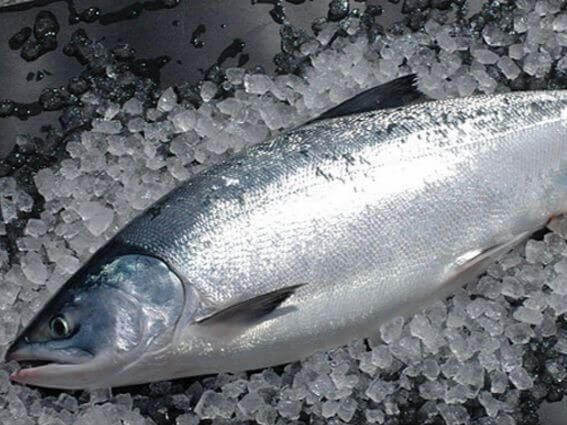 Chum salmon may be called other names depending on when it was caught, how mature the body is, and its taste. Young salmon born in Russian rivers, that are somehow mixed in with the salmon returning to Japan to spawn are called “Keiji”. Chum salmon caught between Spring and Summer during recurrent migration is called “Tokishirazu”, which means ‘unaware of time’, or just Toki.
Chum salmon may be called other names depending on when it was caught, how mature the body is, and its taste. Young salmon born in Russian rivers, that are somehow mixed in with the salmon returning to Japan to spawn are called “Keiji”. Chum salmon caught between Spring and Summer during recurrent migration is called “Tokishirazu”, which means ‘unaware of time’, or just Toki.
Subadult individuals called Mejika are caught at the end of the akizake fishing season. This indicates that secondary sexual characteristics, such as the elongation of the rostrum and the bending of the upper and lower jaws at maturity, which is a characteristic of the salmon family, are not exhibited.
Chum salmon gathered around river outlets that are about to spawn are called “Akiaji” or “Buna” which means ‘beech–as in the tree’ and Chum salmon that has already spawned is called “Hocchare”.
About Change in Appearance and Quality Chum salmon
Chum salmon caught in the sea before swimming upstreat to spawn is called Ginke and both males and females are a shiny silver color. The Ginke also has a relatively gentle face. Migrating Sakuramasu (Cherry salmon) and Masunosuke (King salmon) also have the same sort of silver body. The roe of the Ginke is a sticky yellow, similar to chicken eggs. The egg membrane is removed from this to make the “Ikura” or salmon roe used as a sushi topping.
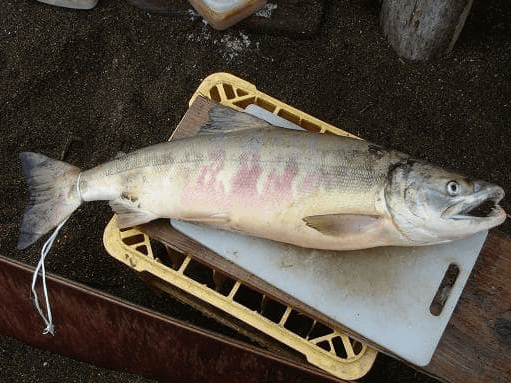
Meanwhile, Chum Salmon gathered at river outlets (Akiaji, Buna, etc.) are mostly shown nuptial coloration (this is the red-purple and block coloring called Bunake or Buna), and the snout of the males start to curve. As the female approaches her spawning time, the black stripes on her sides from the head to the tail really start to stand out. When the Chum salmon drinks river water, the taste starts to decrease rapidly. One reason for this is that Akizake has around 10% fat, but it stops feeding a few months before swimming upstream in rivers, so this fat percentage decreases as it approaches the spawning site.
The fully matured roe of the ‘buna’ rank of Chum salmon has a tough surface like a ping pong ball just before hatching so it doesn’t burst easily in the mouth and the flavor is watered down, so they aren’t suitable to eat. In other words, the roe of the salmon that have already swum upstream is not suitable for making sushi. The name ‘buna’ comes from the color of the body of salmon, which is similar to the color of the bark of a beech tree.
Due to the variety in the color of the meat at markets, even among the same buna, there are even more detailed categories. It generally goes for around $2 to $4 per kilogram.
A Buna: Salmon that are 15 to 30 days away from spawning and caught at the river outlet. The body surface is a silvery-white color, but some of the nuptial colorings start to appear.
B Buna – Salmon that has just started to swim upstream. The nuptial coloring is getting a bit stronger.
C Buna – The flavor has decreased a lot by this point, so this is the lowest grade of salmon at a market. The nuptial colors are strong and black stripes are apparent on the body. At its cheapest, the body goes for 50 cents per kilogram after the roe has been harvested.
Native Chum salmon Distribution Map
Pink salmon (Also called Humpback salmon)
Scientific name: Oncorhynchus gorbuscha (Walbaum)
The standard Japanese name is Karafutomasu. In some Hokkaido production areas, it is called by the brand name, Okhotsk Salmon. These fish are distributed widely from California to Alaska, the Korean peninsula and Hokkaido.
It has evolved over millions of years so that it can live in small rivers that flow into the North Pacific Ocean. The fry feed very little in the river and instead swim downstream to the sea immediately. The period until maturation is like clockwork, and the young fish always return two years after hatching. There is no landlocked variety and this species spends a very short time in freshwater and don’t tend to follow mother‐river migration as strictly. The Pink salmon takes a short trip up a shallow river, returning to its birthplace to spawn. The fact that the upstream distance the Pink salmon travels is short, is apparent in the meat texture. The meat contains very little in terms of fat reserves and lacks the muscle development found in salmon that must travel upstream long distances. Due to its low fat content and lack of muscle development, Pink salmon also lacks the rich, deep flavor–umami–contained in premium salmon found in the Atlantic and Pacific oceans.
In Japan, they primarily swim upstream in the rivers around the Okhotsk Sea and Nemuro Channel. As a food, the body is soft and it is often canned.
Native Pink salmon Distribution Map
Silver salmon (Also called Coho salmon)
Scientific name: Oncorhynchus kisutch (Walbaum)
The standard Japanese name is Ginzake. Wild Silver salmon inhabit the Northern Pacific ocean regions and don’t swim upstream in Japan’s rivers.
After the hatched fry spends one year in the river, it then lives for two or three years in the sea before returning to the river. Its main food source in the rivers is insects, but like the King salmon, once it starts migrating it becomes ichthyophagous and preys on herring and sardines as well as squid. It grows remarkably quickly, reaching about 10 cm when it swims downstream to the sea, and then grows to 40 cm at 2 years and 60 cm at 3 years old while living in the ocean. The color of the meat is an orangish-pink, darker in color than Pink salmon and follows King salmon and Red salmon in red shade.
Most of the Silver salmon currently in circulation has a stable supply from aquaculture. Sea-farmed Silver salmon is fed high volumes of food and grows many times faster than wild Silver salmon. It grows to around 3 to 4 kg in about a year. The taste is good and the size allows for large fillets, so it is used for salmon steak, smoked salmon and salted salmon. They are primarily used for processing and the price is a bit lower.
In Japan, around 100,000 tons of farmed Silver salmon is imported from Chile every year. This farmed version has double the fatty meat of wild Silver salmon. It is especially good for grilling and most of the salmon used in rice balls and bento boxes sold at convenience stores in Japan came from Chile.
On the other hand, Japan farms 15,000 tons of Silver salmon annually and 90% of that is raised in Miyagi prefecture. Special care is taken for the food this salmon is fed, there is no unpleasant odor, the fat distribution is perfect and it has a texture that melts in your mouth. This Silver salmon is managed thoroughly to create the best quality and it is used for Nigiri sushi and sashimi.
Native Silver salmon Distribution Map
Red salmon (Also called Sockeye salmon or Kockanee salmon)
Scientific name: Oncorhynchus nerka (Walbaum)
The standard Japanese name is Benizake. Red salmon are distributed throughout the northern Pacific Ocean, Okhotsk Sea and the Bering Sea.
The most unique salmon evolution is that of the Red salmon. The way it evolved not only resulted in the indisputably richest flavor of all salmon but also the powerful red color. Before most Red salmon descends into the ocean, it spends its first two years in a freshwater lake where it eats tiny shrimp and crabs as well as zooplankton. Afterward, it continues the same diet even after maturing and going out to sea. As it consumes high amounts of the carotenoid pigment, Astaxanthin, it has a high carotenoid pigment content compared to salmon that eats small fish, squid and jellyfish. Red salmon meat has a bright and highly concentrated color and is dense because of this diet.
There are no wild Red salmon born naturally in Japan’s rivers. They are the same in that they are born in rivers, grow in the sea, then return to the river, but a unique characteristic is that they spend years in a lake they come across partway through the river. Therefore, in order to breed Red salmon, there must be a lake on their upstream route. The aquaculture hasn’t been established for this type, so they are all wild. They are mainly used in canned, frozen, or salted fish. They are also deliciously smoked. In Alaska, where aquaculture is completely banned, wild-caught Red salmon and Silver salmon are frozen, the parasites are killed, and then they are used for sashimi and sushi.
Native Red salmon Distribution Map
Atlantic salmon 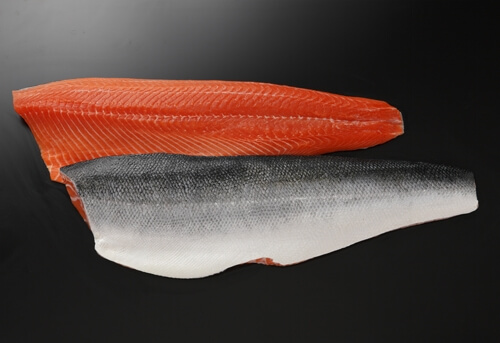
Scientific name: Salmo salar Linnaeus
The standard Japanese name is Taiseiyosake. Natural Atlantic salmon is widely distributed around the North Atlantic and its tributaries. It has been transplanted to many countries since 1860 and lives naturally in the waters of Finland, New Zealand, Australia, Argentina and Chile. It can grow to 120 cm and weigh 40 kg. Wild Atlantic salmon goes by a number of aliases depending on when and where it is fished.
Meanwhile, it is farmed in salt water for food throughout the world. Farmed Atlantic salmon are chilled from their locales, then distributed by air. They are never frozen, so they have a relatively nice texture and they are characterized by the fat content and delicious-looking color. It is the most expensive type of farmed salmon. They are also the first fish farmed in seawater in Europe.
Atlantic salmon farmed in the Fjords of Norway is branded as Norway salmon, which can be called a pioneer for Farmed Atlantic salmon. Once it leaves Norway’s aquaculture farm, it is processed into fillets or dress at a processing plant adjacent to the port, then amazingly makes it to the shelves at Toyosu Market in 36 hours. It is important to note that genetic modification of farmed salmon is forbidden in Norway and this is strictly monitored through regular on-site inspections. In order to make this differentiation in the Japanese market, it is sold as Aurora salmon with an emphasis on its premium flavor. Some long-established sushi restaurants may also start using Atlantic salmon for Nigiri sushi in the future. Incidentally, other brands of Atlantic salmon include Scottish salmon, Canadian salmon, Faroe salmon and Tasmanian salmon, among others.
Native Atlantic salmon Distribution Map
Rainbow trout (Wild)・Steelhead
Scientific name: Oncorhynchus mykiss (Walbaum)
Rainbow trout is found in North America from Alaska to the northwestern part of Mexico and in the Kamchatka Peninsula. It is named for the wide vertical shiny, rainbow stripe on the side of its body. From the end of the 19th century, it transplanted to nearly all areas in North America, South America, Australia, New Zealand, Japan, Taiwan and Europe. It grows to lengths of 40 to 60 cm. The standard Japanese name is Nijimasu.
It was imported from the United States into Lake Chuzenji in Japan in 1877, and it is now a general and central presence as farmed salmon. It is primarily farmed in freshwater. Tests for saltwater farming also began in 1971, but most of those activities were abandoned. However, this has been reviewed in recent years with an aim to build a new pillar of revenue to supplement chum salmon due to continued poor catches. Meanwhile, saltwater farmed Rainbow trout is already being distributed. An example can be seen in Miyako Trout salmon from Miyako City, Iwate Prefecture.
Salmon that is small and always stays in streams is called Rainbow trout. On the other hand, there is also a group that descends into the sea, grows there, and then goes upriver to spawn. The body is silver in color while the head shines like steel, giving it the name Tetsu or Tetto in Japanese and Steelhead in English. It normally grows to around 75 cm and weighs about 4.5 kg, but it may grow longer than 1 meter in length and reach 15 kg. The reason is unknown, it doesn’t have a name ending in salmon or trout.
The spawning season is from April to May. However, the timing of swimming upstream differs depending on the river. This upstream journey is called a “run.” There are broadly three types of runs. In one type, known as the “summer run type”, the run takes place between March and November, so that the fish ends up at its respective spawning site by autumn, then spends winter in that site before laying its eggs the next Spring. Another type, known as the “winter run type,” sees the steelhead entering the river between November and December, spending winter there and then laying its eggs in the spring. Finally, in the “spring run type,” the steelhead runs upstream directly before laying eggs in spring. The difference between summer runs and spring runs is whether or not the fish spawns right after arriving, or spends a summer to winter in the river before spawning the next year.
Steelhead spawns in the same way as salmon, and the hatched fry live in the river, exactly like Rainbow trout. If Steelhead and Rainbow trout were mixed together at this point in their development, it is impossible to distinguish between young Steelhead and land-locked Rainbow trout. It’s not until about two years later that they can finally be told apart. Rainbow trout start to mature at this time while those planning to descend into the sea do not. The two names show that they were thought to be different fish. It is unique among the Pacific salmon in that they have the ability to spawn more than once (called iteroparity).
| Region | Representative Rivers / Range | Notes |
|---|---|---|
| Alaska (USA) | Situk River, Kenai River, Kasilof River, Copper River basin, Kenai Peninsula streams | Known for strong steelhead runs in several coastal drainages. |
| British Columbia (Canada) | Skeena River, Fraser River, Bulkley River, Dean River | World-renowned steelhead fisheries. |
| California (USA) | Eel River (plus other Pacific coast rivers) | Historically large steelhead runs; current populations vary by watershed. |
In places like the rivers of British Columbia province of Canada and Washington state of the US, the Steelhead makes runs upstream and game fishing is booming. Angling for wild steelhead in British Columbia and Washington is 100% catch and release. In the rivers of Hokkaido in Japan, it is rare to catch steelhead, so you won’t see it in Toyosu Market.
Rainbow trout can be purchased at Toyosu Market, but it is generally used for dishes other than sushi. We have no information on whether Steelhead is used in sushi restaurants or not, but Rainbow trout (Nijimasu) and Steelhead don’t sound like very delicious sushi.
Native Rainbow trout Distribution Map
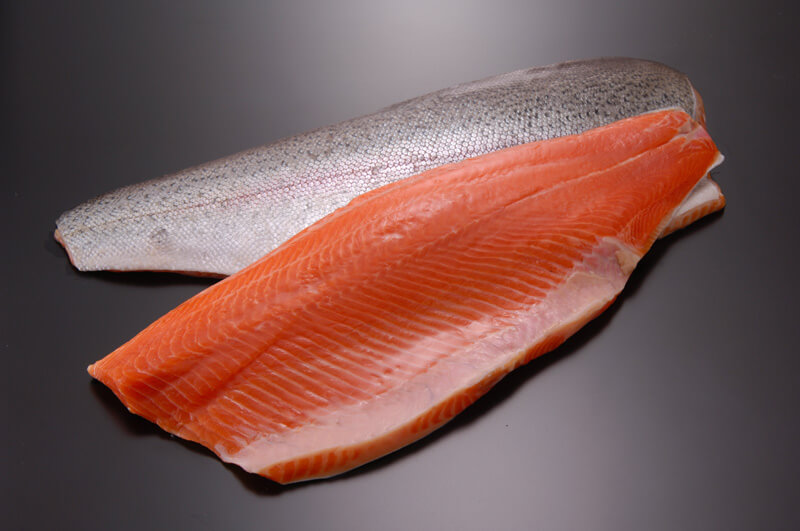 Salmon trout
Salmon trout
Rainbow trout has one of the more ample appetites of salmon and it is omnivorous. Therefore, it makes sense that it grows at a faster rate than other salmon and is the most suitable for farming. Furthermore, this growth speeds up even more when raised in the sea, increasing its size by about five times over six months. It is called both Trout salmon and Salmon trout. These names aren’t actually indicative of the species of the fish but is the distribution name for Rainbow trout farmed in sea water.
As aquaculture grows, the farmed fish undergo selective breeding. For example, of all the large Rainbow trout, those with small heads and fat bodies were selected and bred over many years to create the Donaldson trout. It is characterized by its growth to large sizes. While a normal, farmed Rainbow trout grows to about 30 to 40 cm, the Donaldson trout grows up to 60 to 70 cm, about the same as a chum salmon. A hybrid made from breeding a female Donaldson trout and a male Steelhead is called the Donaldson steelhead, which grows even faster.
Generally, it is distributed frozen, as fillets. This is the type that is just called, “salmon” at conveyor belt sushi restaurants and grocery stores as take-out sushi. Production is stable, they are cheap and taste good. They are characterized by not having the strong odor that salmon is known to have.
Main types of salmon used in sushi throughout the world
Almost all of the salmon used as a topping at sushi restaurants throughout the world are Salmon trout farmed in the sea in Chile, Norway, etc., or Atlantic salmon farmed in the seas in Norway, Australia, etc.
Types of salmon and their quality in major producing countries
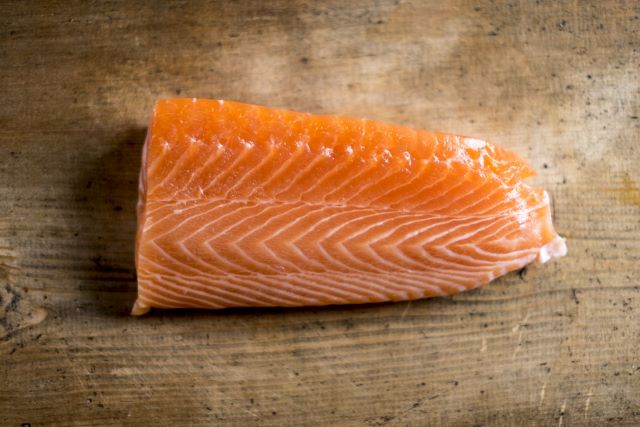
Salmon is attractive because of its shiny orange color and fatty taste.
Types of Japanese salmon
Rainbow trout selective mating-type breeding
Rainbow trout normally reach maturity in two years but nutrients are taken by eggs and sperm in mature fish, causing an inevitable drop in meat quality, so they are shipped before the 2-year mark. However, some of these individual fish reach maturity at three years, and naturally they grow bigger over the extra year. Therefore, using the 3-year type, individual fish with advantages such as better meat quality and flavor, are repeatedly bred together to create more delicious Rainbow trout. The most well-known of these is the Donaldson rainbow trout improved from repeated, selective breeding of sea-run variety of Rainbow trout and large rainbow trout.
In Aomori prefecture, Donaldson rainbow trout is raised in the Tsugaru Strait and distributed under the brand Kaikyo (Kaikyo means strait) salmon. It is raised in freshwater for two years and then bred in rough sea waters for 8 months before distribution. The special feed made mostly of fish meal, also includes a mixture of bananas, which are high in antioxidative components to reduce odor, and fresh Kuma Bamboo Grass that grows wild in the Mt. Hakkodasan foothills, so the fish is known for not being heavy despite being fatty, and its sweetness. Low-density is maintained in the fish cage (2 to 4 fish per square meter), allowing the fish to swim around freely and reducing stress. At the time of shipping, individual fish with good growth are selected and moved to a different live cage. These fish are then not fed for a certain amount of time in order to create a finished product that isn’t heavy and has good meat quality. After that, each individual fish is drained of its blood by hand, Ikejime is performed and the fish is cooled in ice water to prepare for distribution. Generally larger Rainbow trout don’t have a strong flavor, but Kaikyo salmon have better flavor the larger they are.
Shizuoka boasts the highest amount of Rainbow trout production in Japan. When farming Rainbow trout, which require clean water at or below 20°C that is rich in oxygen, the area around Mt. Fuji, which is rich in natural water around 10 to 15°C and has clean air all year long.
Here, eggs and sperm from superior lines of Rainbow trout are crossbred, they are then raised on a highly balanced feed mix. At least two days before distribution, feeding is stopped so that any feed left in the fish’s body is completely digested, feces are excreted, so the body is firm in the finished product. The fish are thoroughly drained of blood and undergo Ikejime at the time of distribution. Then, after a longer-than-usual growth time has passed and the fish has reached an especially large size of 2 kg or more, the carefully raised Rainbow trout is distributed under the brand, Aka-fuji (赤富士). This meat has a fine texture, no strong peculiarities in flavor, and high-quality fat distribution, and is suitable for eating raw.
Rainbow trout bioengineering-type breeding
A version bred not by selective mating but by bioengineering with three sets of chromosomes (normal fish have two sets of chromosomes) is called the Triploid rainbow trout. As this fish does not mature, the flavor and texture of the meat are greatly improved, allowing for distribution under the best conditions all year.
The spring water from the snowy mountains of Hokkaido (where snow remains even in July) is chilly and maintains an average of 7°C year-round. Triploid rainbow trout raised in these waters is called Ginga (Ginga means galaxy) salmon and is known for its firm meat and minimal odor.
However, as Ginga salmon is raised in cold waters, it grows slower than the Rainbow trout raised in warmer climates, such as Honshu, and takes three and a half years to reach 1 kg. It is also raised with natural selection, avoiding the administration of antibiotics or pesticides, meaning that only the fittest survive and are then distributed as Ginga salmon.
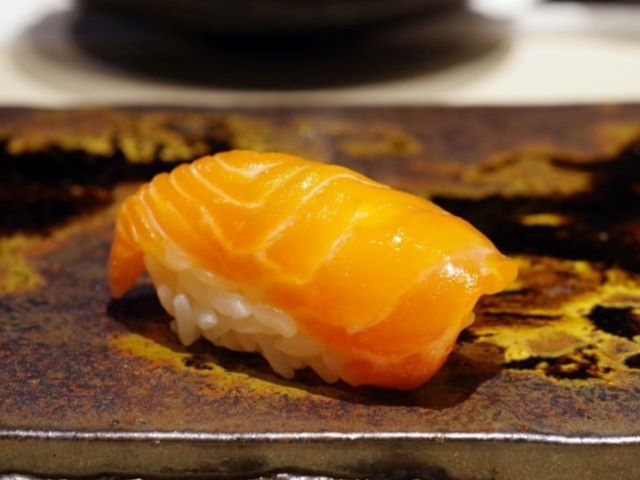
Yashiomasu’s Nigiri sushi is already being offered.
Yashiomasu is a type of Triploid rainbow trout developed in the Tochigi Prefectural Fisheries Experiment Station. It is carefully raised for two to three years in harsh conditions that freeze over in winter and given a feed mixture that includes olive oil. Therefore, the subcutaneous fat contains high amounts of oleic acid, which has a very low melting point, so it melts in your mouth better than other types of salmon and also has a refreshing flavor.
Rainbow trout crossbreeding
Farmers are not just making bigger and bigger Rainbow trout, they are also conducting research to make the fish more delicious while breeding fish with advantages not typical to Rainbow trout in order to create new breeds. For example, breeding Rainbow trout and Iwana together just results in fries that hatch from eggs but do not grow. However, with triploid processing it is possible to breed different types of fish.
Nijimasu (Rainbow trout) females, Amago salmon males and Iwana males that were spotless due to a mutation were bred to successfully create Niji-ama and Niji-iwa. Niji-ama meat is red like the Sockeye salmon with a fresh sweetness, no odor, and melts in your mouth. It is easy to raise and produced every year. Meanwhile, Niji-iwa meat is white with a nice, chewy texture and nice fat distribution. However, it is difficult to farm and only produced biannually. Launched on the market in 1999, it is called the Kinuhime (Kinu means silk) salmon and like its maternal Nijimasu, both types are free of spots and dapple patterns to create the characteristic, beautiful appearance.
Also, Rainbow trout is particularly susceptible to viruses such as infectious hematopoietic necrosis. In order to make up for this, in 1994 the Nagano Prefectural Fisheries Experimental Station tried a new development. The European brown trout was selected as the breeding mate for the Rainbow trout. About 10 years were spent to succeed in creating a fish with the advantages of both species, resulting in the Shinshu salmon. The appeal of Shinshu salmon is that it develops better than Rainbow trout, has a fine texture, no strong peculiarities in flavor or odor, and goes well with a wide variety of dishes.
The children of Rainbow trout and Brown trout that are just bred, don’t really grow. Therefore, high hydraulic pressure is applied to the fertilized eggs of normal (diploid) Rainbow trout in order to make tetraploid Rainbow trout with double the normal number of chromosomes. The eggs taken from the grown, female tetraploid Rainbow trout is then fertilized by the sperm of the diploid Brown trout to create Triploid Shinshu salmon.
Neither male nor female Triploid Rainbow trout create offspring, but since the female do not carry eggs, the nutrients are used for the fish’s own growth, creating bigger fish with better quality meat. There is also a technique used concurrently to make all the fish female. Androgenic hormones are used in female diploid Brown trout in order to convert the sex of the fish. These are fish made to create sperm that only has female chromosomes. These fish are used to fertilize the tetraploid Rainbow trout, so all the Triploid Shinshu salmon that hatch are female. This method was first used in Japan, and it is even difficult to create tetraploid Rainbow trout with hydraulic processing, so developing a stable technique for efficiently creating Triploid Rainbow trout was recognized worldwide.
The technique of increasing chromosomes using water temperature and hydraulic pressure differs from the technique of creating crossbreeds and triploids using gene splicing (gene recombination). This technique is already used often in plants, and there is no danger in using it on food products. Even if a Triploid Rainbow trout somehow escaped into the wild, they are all females with no reproductive capabilities, so there is no risk of crossbreeding with wild species or disruption to the ecosystem.
Himemasu bioengineering-type breeding
Himemasu refers to the Sockeye salmon, which is a species that stays in the rivers instead of migrating to the sea. It is known for its nice taste but it is a timid fish and its scales come off easily and it is susceptible to illness and stress, meaning that it is not really farmed. It was the Iwate Fisheries Cooperative Association that took on this challenge, succeeding in farming the first triploid Himemasu in all of Japan.
Normally the Himemasu sees a decrease in meat quality and flavor between August and October, when approaching spawning season, and cannot be sold. The association made it so that a Himemasu in good condition that has undergone triploid processing can be distributed at any time to cover this time period. For farming, Kanazawashimizu (金沢清水) is used, which is one of the top 100 famous types of water in Japan. It is hard mineral water that stays around 12°C year-round, and the water quality and temperature are strictly managed, so there is no concern for parasites.
Ginzake selective mating-type breeding
The meat of the Ginzake (Coho salmon) is a bright orange color with a good balance of fat and umami with no peculiarities in taste, so it is easy to eat. Farming research started in the 1960s and was implemented in the 1970s. The shores of the northern part of the Oshika Peninsula in Miyagi prefecture are a typical deeply indented coastline with deep waters and a calm tide, so there are many bays suitable for farming fish. The sea temperature in mid-July is also low, at 20°C or less and many seedling production sites utilize the rich meltwater from the Zao Mountains, creating the perfect environment to cultivate Ginzake.
Starting around 1996, the feed was switched from sardines to artificial feed, which successfully led to eliminating the fish odor and improving the flavor. Also, techniques to maintain freshness improved with Ikejime, making it possible to produce farmed Ginzake to eat raw and ensure stable production at a high quality. The brand of this fish is Date-no-gin and as this fish is distributed skinned and completely boneless, it is easy to prepare, even for people who aren’t used to preparing fish.
Salmon from France
In the case of salmon aquaculture, the location of the fish cage is the most important factor for quality, whether it is at sea, in a lake, or a river. In addition to the food that people feed the fish, they also eat plankton and other organisms in the water. Therefore, the quality of the water will affect the flesh, taste, and flavor of the fish. In addition, the fish swim more actively in areas with strong currents, so the flesh is firmer and the fat is more easily absorbed if the water temperature is cooler.
Atlantic salmon from the Bretagne region of France is characterized by its rather light fat content and bland flavor. Within France, salmon are farmed in Bretagne and Normandy, but the annual production is only 1,200 tons. Therefore, France has to rely on salmon imports, even though it is the largest consumer of salmon in Europe.
Of concern was a contamination study of farmed salmon that surprisingly revealed that organic farming salmons were more contaminated than conventional intensive farming salmons. As a result, there was a temporary drop in the consumption of farmed salmon.
Although Ireland is particularly well known for its organic salmon farming, and Norway is also focusing on organic farming to improve its image, the survey showed that organic products performed poorly, irrespective of where they were produced.
Salmon from Norway
Natural salmon cannot be eaten raw due to the risk of the parasite Anisakis and must be cooked at 60°C or higher or frozen at -20°C or lower. However, farmed salmon, whose diet is completely controlled, are free of parasites and can be eaten raw without worry.
Salmon farming is currently expanding and developing on a global scale. Norway stands out not only because of its intricate coastline and cool climate but also because of the strict quality control system established by the government, from fertilization to landing.
As Norway is an environmentally advanced country, the number of fish farmed is virtually limited to the size of the fish cages. To prevent water pollution in the sea area, a fallow period is always required in the sea area after one generation of fish farming is completed. In the unlikely event of a fish disease outbreak, the fish are treated according to the instructions of a veterinarian dispatched by a government agency, and only those that have passed a rigorous re-inspection are allowed to be shipped.
The most notable feature is the world’s unparalleled landing technology. To prevent the quality of the meat from losing due to stress, the fish is transported from the fish cage in a boat with a water tank, and after arriving at the landing site, the fish is allowed to calm down for 3~4 days before being put into a state of suspended animation by electric shock and then Ikejime.
Norway also farms rainbow trout, also known as trout salmon or salmon trout, which are characterized by their firm texture and bright red color in contrast to Atlantic salmon, which have a softer flesh. It is more suitable for raw consumption.
Salmon from Scotland
In Scotland, there are some famous rivers where Atlantic salmon run, including the River Dee, and those caught here are called Scotland wild salmon.
Salmon farming is also thriving, second only to Norway and Chile. It is not temperature-controlled at the fry stage, and its growth rate is left to nature, resulting in a low density of farming, abundant locomotion, a thick back, and firm flesh.
The fish is also characterized by a slightly lighter fat content and a light flavor. Farmed salmons are certified as Label rouge in France.
Salmon from Ireland
In Europe, a leading organic country, organic farming of Atlantic salmon has recently become increasingly popular. The organic feed used at a farm in western Ireland is made from fishmeal and fish oil that is not genetically modified and does not contain any antibiotics, vaccines, or food additives. The company is thorough in its use of naturally occurring yeast called Phaffia yeast for the pigment astaxanthin, which is used to make the body color red.
The currents are very strong near Clare Island, which allows the fish to swim around all the time. This is why the fat content is said to be half that of Norway salmon. It is called “whale salmon” because of its firm flesh and well-developed tail fin. Its flesh color is pale pink, and it does not have the peculiar smell of farm-raised fish. Its sweetness increases when it is heated.
Salmon from Denmark
The waters around the Faroe Islands in the Denmark territory are where the warm currents from the North Atlantic Ocean and the cold currents from the Arctic Ocean collide, resulting in fast currents and good quality seawater. The strong winds and cool temperatures even in summer make it an ideal place for salmon farming. Salmon swim actively in the fast ocean currents, so their flesh is firm and any uneaten food is washed away and does not accumulate at the bottom of the fish cage, making the fish hygienic and healthy.
Smelt, herring, and mackerel, which are caught in abundance around the Faroe Islands, are processed into bait at a factory on the island while they are still fresh. It is said that the freshness of the bait material is related to the smell of the farmed fish. Faroe Islands’ Atlantic salmon has no farmed fish smell, is easy to eat, and is highly regarded for its sweetness and redness.
Salmon from Canada
Six species of salmon (King salmon、Coho salmon、Sockeye salmon、Chum salmon、Humpback salmon、Atlantic salmon) inhabit the Pacific coast of Canada, and from spring to autumn, five species of salmon, excluding Atlantic salmon, migrate upstream one after another.
Most of the wild salmon are caught in the coastal zone of British Columbia, of which Sockeye salmon is the most commercially important species. It is characterized by its shiny silver back and bright red flesh and has a fat content of more than 12%.
Salmon farming, on the other hand, has developed mainly on Vancouver Island in British Columbia, where the most common species farmed is Atlantic salmon. British Columbia’s Atlantic salmon has received an Aquaculture Stewardship Council certificate and is highly valued.
Salmon from the United States of America
Surrounded on three sides by the Arctic Ocean, the North Pacific Ocean, and the Bering Sea, Alaska is a treasure trove of nature, with a range of steep mountains shaped during the Ice Age in its central part, approximately 300 lakes and marshes, and over 2000 rivers.
In the early 1960s, overfishing led to a worldwide decline in salmon catches. There were two options: to mass produce salmon stably by aquaculture or to restore natural fertility by preserving the environment and nurturing the ecosystem.
In 1990, Alaska banned aquaculture completely to prevent pollution of seawater by aquaculture feed and established detailed regulations on the fishing methods, timing, waters, and amount of fish to be caught to maintain the ecosystem. In addition, since 1986, the National Oceanic and Atmospheric Administration has periodically sampled 44 different pollutants, and no pollutants that could affect humans have ever been detected in the vicinity of any of Alaska’s 12 fishing grounds, assuring safety.
Since wild salmon migrate through the ocean and acquire the nourishment needed to migrate upstream, their flesh is exceptionally tight and fatty, and they are highly prized for their delicious taste. King salmon has long been preferred in the U.S., but consumption of Sockeye salmon, with its beautiful red flesh, has been increasing in the past 10 years, probably due to the Japanese food boom. Americans have a strong preference for wild salmon, while farmed salmon dominates the distribution in Europe. However, Alaskan salmon is also exported to Europe, where it is mainly used for smoked salmon. Of the many rivers in Alaska, the Yukon River, known for its grandeur, flows from Canada across Alaska to the Bering Sea. Salmon caught here are treated exceptionally well, especially King salmon, which are called King of King salmon.
Salmon from New Zealand
Salmon is originally a northern hemisphere fish, but with the expansion of the market, it has come to be farmed in the southern hemisphere as well. The only species of salmon farming in New Zealand is King salmon. New Zealand now accounts for more than 90% of the world’s king salmon production. Compared to other salmon, King salmon move faster, have thinner skin, and are more vulnerable. They are not resistant to disease and require a high level of skill to farm.
The farm is located in Marlborough Sounds, a beautiful inlet on a deeply indented coastline, in a wildlife preserve, with saltwater rushing in from Cook Strait. The fish cages are kept clean by strong tides and sunlight, and no anti-fouling or cleaning agents are used.
There are no disease outbreaks of salmon in these waters, and no antibiotics, vaccines, or drugs are used. The diet is nutritionally balanced with added protein and vitamins, and the fish are healthy-sized, well-colored, fatty, and firm. This King salmon contains over twice the omega-3 fatty acids as Atlantic or Trout salmon.
To evaluate the safety of salmon quality, an American public agency compared and evaluated salmon produced in different countries regarding drug use, number of die-offs, feed safety, etc., and only King salmon from New Zealand received a green mark for safety. The brand name is Ora King salmon.
Salmon from Australia
Tasmania, the southernmost island of Australia, is a World Heritage-listed wilderness area covering about 1/3 of the island and is blessed with unparalleled clean air and the cool waters of the Antarctic Ocean. The Atlantic salmon farmed there is called Tasmania salmon and is highly valued.
The Tasmanian government has established three regulations to protect the ideal natural environment. Avoid overfeeding. The location of the fish cages should be changed every year. The most important feature is to reduce the density of aquaculture in the fish cage. This allows the fish to grow more freely at a lower density than in other countries, which reduces stress, increases physical activity, and results in healthy, firm, high-quality flesh and a beautiful fish body.
Sea-farmed Rainbow trout, also known as Ocean trout, grow in low densities similar to Atlantic salmon. The Macquarie Harbour, located in the western part of the island, has good water quality where fresh water and sea water mix, resulting in a much firmer Rainbow trout.
Salmon from chile
Chile accounts for nearly 30% of the world’s total salmon production and 60% of Japan’s imports. It now produces about 1 million tons, second only to Norway in the world. It accounts for more than 90% of the world’s Coho salmon farming; more than 20% of Atlantic salmon; and about 40% of Salmon trout.
Salmon trout is produced in the Patagonia region of southern Chile, close to Antarctica. The cold Humboldt Current, which flows northward from Antarctica, keeps the water temperature low throughout the year. In addition, salmon is farmed in brackish waters fed by mountain snowdrifts, an environment suitable for the growth of salmon trout.
However, as salmon farming has developed into a key industry in Chile, there is a growing demand for a shift to “sustainable farming.
Main types of salmon used in sushi in Japan
In the first place, salmon is a sushi topping that isn’t used as a normal nigiri topping at sushi restaurants in Japan (see here for the reason). However, lately, at conveyor belt sushi, it has become the most popular topping by far. The beautiful coloring and the soft fatty texture suit the taste of people today. These are mostly Salmon trout and Atlantic salmon. However, in Japan, it is considered to be a specifical conveyor belt sushi topping and there are still very few Edo-style sushi restaurants that serve sushi with Salmon trout or Atlantic salmon toppings.
However you will find some top-grade sushi restaurants that serve rare salmon sushi toppings such as Masunosuke, Tokishirazu, Keiji and Sakuramasu caught during migration off the shores of Hokkaido, etc. Be careful when ordering salmon sushi in high-end sushi restaurants. One reason is that it’s likely they don’t stock such a thing (meaning Salmon trout and/or Atlantic salmon), and don’t forget that some older chefs may be annoyed at such an order.
Let’s also take a look at some rare types of salmon
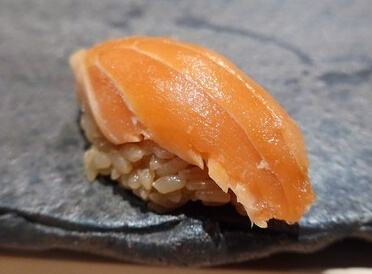 Masunosuke (鱒の介)
Masunosuke (鱒の介)
The Japanese “Masunosuke,” refers to King salmon. This is the largest of salmon with especially high-fat content and it is definitely the king of salmon when it comes to taste as well. Masunousuke (King salmon) especially prefers cold waters compared to other salmon. It lives at a high latitude and mainly habits the northern Pacific Ocean from the Kamchatka Peninsula to Alaska. On rare occasions it will even migrate to the seas surrounding Japan and although it can be fished mainly in Hokkaido, catches are extremely rare. Therefore, it sells for high prices. There are no rivers in Japan that serve as permanent spawning grounds for this salmon. The peak season is from spring to early summer.
In the past, salmon was an exclusive item for conveyor belt sushi and was never served at Edomae sushi restaurants. However, the number of high-end sushi restaurants that serve Masunosuke (Wild King salmon) is steadily increasing. For example, Nihonbashi Kakigaracho Sugita (日本橋蛎殻町すぎた), Sushi Akira (すし良月), and Sushi Kimura (すし㐂邑) are actively offering it when good fish is available. The image on the right is Masunosuke Nigiri sushi.
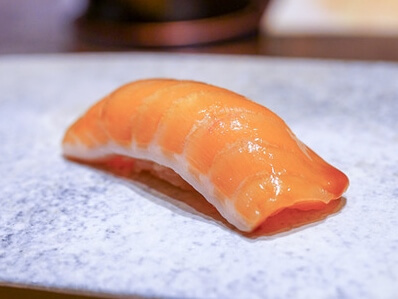 Tokishirazu (時不知 or 時鮭)
Tokishirazu (時不知 or 時鮭)
The Japanese “Tokishirazu” refers to Chum salmon. Tokishirazu is salmon caught from spring to the beginning of summer. They are the same chum salmon found in the fall, but since they aren’t caught during the spawning season, the fish don’t have eggs or milt, and instead have a high-fat content. The name “Tokishirazu” stems from the fact that these fish are caught out of season, in summer and the name means ”ignorant of time”. What it is called differs depending on the region. In Hokkaido, it is called Tokishirazu or Tokizake. In the Sanriku region, it is called Oome or Oomemasu.
It has a higher fat content than Ginke and Mejika and sells for more than $20 per kilogram. The premium fat envelopes the sushi rice without a hint of the odor salmon is known for. Also, Hokkaido sushi restaurants sometimes venture to make fresh Tokishirazu into Zuke as a method to fully bring out its umami. Even when it comes to high-end sushi restaurants in Ginza and Nishiazabu, there are very few that serve Tokishirazu Nigiri sushi. The most likely restaurant you will find Tokishirazu Nigiri is Sushi Sho in Yotsuya, and the several small restaurants opened by chefs who apprenticed there. The image on the right is Tokishirazu Nigiri sushi.
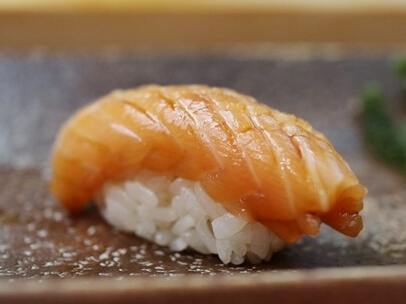 Keiji (鮭児)
Keiji (鮭児)
The Japanese “Keiji” refers to Chum salmon. Keiji is young salmon with immature ovaries or testes. Only 1-2 Keiji are found in a normal catch of 10,000 salmon. No more than a few hundred can be caught each year in the Shiretoko area of Hokkaido. Normal salmon fat content is 2-15% but the Keiji has a very high body fat percentage at 20-30%. Keiji is found mixed in with the chum salmon, caught in the fixed shore nets for fishing things like Shiretoko and Abashiri, so the salmon swimming upstream in the Russian rivers are said to have “strayed off course”. Keiji is a fish weighing up to only about 4 kg. The price range is between 500 and 2.000 US dollars per fish.
There are even fewer restaurants that serve Keiji Nigiri sushi than there are that serve Tokishirazu. It is sometimes available at Sushi Kutani in Ginza, which specializes in Hokkaido sushi toppings, but it is reserved for regular customers and not something that a new customer will be served on their first visit. Put in terms of tuna, the taste is more like Mejimaguro Harasu, rather than Otoro. Surprisingly, the high-fat content isn’t very noticeable and the meat is smooth with an incredible texture. The fat that tells of the fish’s youthfulness, harmonizes well with the sushi rice. The image on the right is Keiji Nigiri sushi.
Sakuramasu (桜鱒)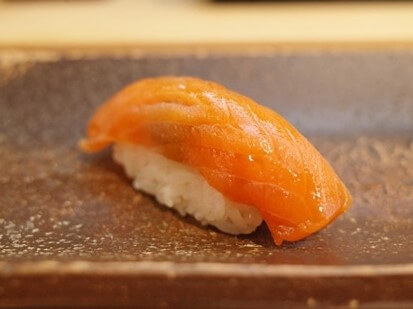
Scientific name: Oncorhynchus masou (Brevoort)
Sakuramasu is an endemic species to Japan, so the English name is a direct transliteration of the Japanese pronunciation. It is also known as Masu salmon or Cherry salmon. It is found in the Chishima Islands, Sakhalin, the Southern part of the Kamchatka Peninsula, the Sea of Okhotsk, and the Korean Peninsula, which is the lowest distribution area of any type of Salmon.
They are caught in the rivers near the estuaries when swimming upstream. Normally they spend a year and a half in the rivers and then descend to the sea in the spring. After migrating in the ocean for a year, they return to their home river to swim upstream the next spring. In contrast, the type that stays in the river without descending into the sea is called Yamame. The taste is supreme when eaten raw, but there is a risk of parasites so they are frozen immediately after catching, just in case, and then used as a sushi topping after a certain amount of time has passed. It has a strong umami flavor and a perfect sweetness. The peak season is spring.
Incidentally, in Japan, Sakuramasu that don’t eat for the short time after entering the river are said to have lost the odor of the feed and have a more refined taste than Sakuramasu caught in fixed fishing nets right before setting off to swim upstream.
And, the Biwa trout, which is a subspecies of the Cherry salmon only found in Lake Biwa, lives in freshwater, and thus never causes food poisoning by Anisakis. This makes it suitable for sashimi and sushi, but it is frozen before it is used at sushi restaurants, just in case. This is because it does not lose any freshness or flavor even when frozen. The image on the right is sakuramasu sushi.
Native Sakuramasu Distribution Map
Mejika (目近)
Chum salmon that climbs the rivers of Niigata and Yamagata, and is caught in Hokkaido during its migration, is called Mejika. It gets this name from the fact that the distance between the eyes and snout is very short. It also doesn’t have the characteristic hooked snout (kype) unique to spawning season and the silver scales peel off easily and have a black luster. It is caught from October to November, which is the end of the fishing season for Akiazake. It has a lower maturity stage than Ginke and also has a nice fat distribution due to storing nutrients in preparation for swimming upstream. It is often said that males get fatty on the belly side, while females get fatty on the dorsal side. This is a rare salmon as it accounts for only 1 in 1,000 of salmon caught in fixed nets and it goes for $10 to $20 per kilogram.
Is salmon a red fish? Or is it a white fish?
The characteristic orange-red color of salmon meat comes from carotenoid fat-soluble pigments, especially astaxanthin. The components of these pigments are the same as the red coloring in the shells of shrimps and crabs. In the case of shrimps and crabs, in some cases, the red coloring isn’t apparent until protein combines with the pigment components through heat, but these pigment components are the same as those that give salmon meat the red color.
Astaxanthin is chemically relatively stable and if components that promote oxidation are generated, astaxanthin quickly prevents oxidation from progressing.
Salmon returning to their home river for spawning stop eating. As preparation for spawning, their nuptial colors appear on the body surface and the shirozake body starts to change (male snouts curve, females gain black stripes, etc.). In Japanese, this is called the “buna (ブナ)” stage. The meat quality of shirozake in the buna stage drops rapidly. Astaxanthin in the muscle is used to generate the nuptial coloring. Meanwhile, shirozake that wander around their home river during the non-spawning seasons are called “tokishirazu”. The reason the tokishirazu meat is so delicious is likely because the fish’s body is not preparing for spawning and so the meat hasn’t deteriorated.
Salmon climb upriver for spawning. The harsh journey requires a lot of energy, but active oxygen is generated at the same time. When active oxygen is generated in excess, the salmon tires during the journey and is unable to finish climbing the river. This is why they store ample amounts of astaxanthin, which has strong antioxidant effects, in the muscles, and eliminate the active oxygen in their effort to reach the final destination. Salmon that have reached the final destination next transfer the astaxanthin stored in their muscles to the roe. This is to protect the eggs, which are laid in shallow waters that are bombarded with bright ultraviolet rays, from genetic disorders and lipid oxidation.
Incidentally, the antioxidative activity of astaxanthin against active oxygen is said to be 6,000 times that of vitamin C and 800 times that of coenzyme q10, while the antioxidative activity against lipid oxidation is said to be 1,000 times that of vitamin E.
When carotenoid pigment is removed from the muscular substance of salmon, the meat does not appear as a dark red color. The dark red color of the meat of tuna and bonito is from the high content of the pigment myoglobin in the meat. Therefore, these are called red fish. On the other hand, sea bream and flatfish, which do not contain high amounts of myoglobin, are called white fish.
The question of whether salmon is a red fish or a white fish, based on the low content of myoglobin in the muscle, is considered to be a white fish. However, salmon muscle does contain high amounts of creatine and anserine, and also tends to have high levels of histidine. These tendencies are mostly consistent with red fish, and salmon shows aspects common in red fish. This makes it a difficult fish to classify.
However, as a sushi topping, it is classified as a white fish.
Salmon color requirements
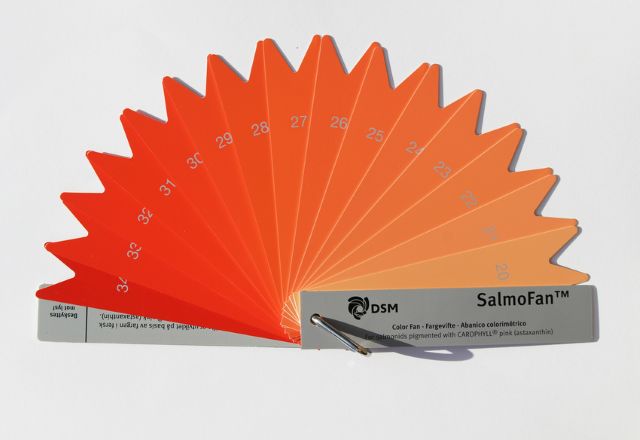
The appearance of SalmoFan™ color measurement scale
The global market size of astaxanthin reached 815.8 million USD in 2023. The synthetic astaxanthin market is dominated by major players such as BASF, DSM, and Cyanotech etc. Synthetic astaxanthin derived from petroleum is used to color salmon.The SalmoFan™ color measurement scale by DSM is recognized as the industry standard across the world for measuring salmon fillet color.The coloring is determined by the period and concentration of mixing astaxanthin into the feed. The salmonid flesh color which are preferred by buyers and customers in different countries, and for different processes, are highly variable.
Salmon Nutrition and Effects
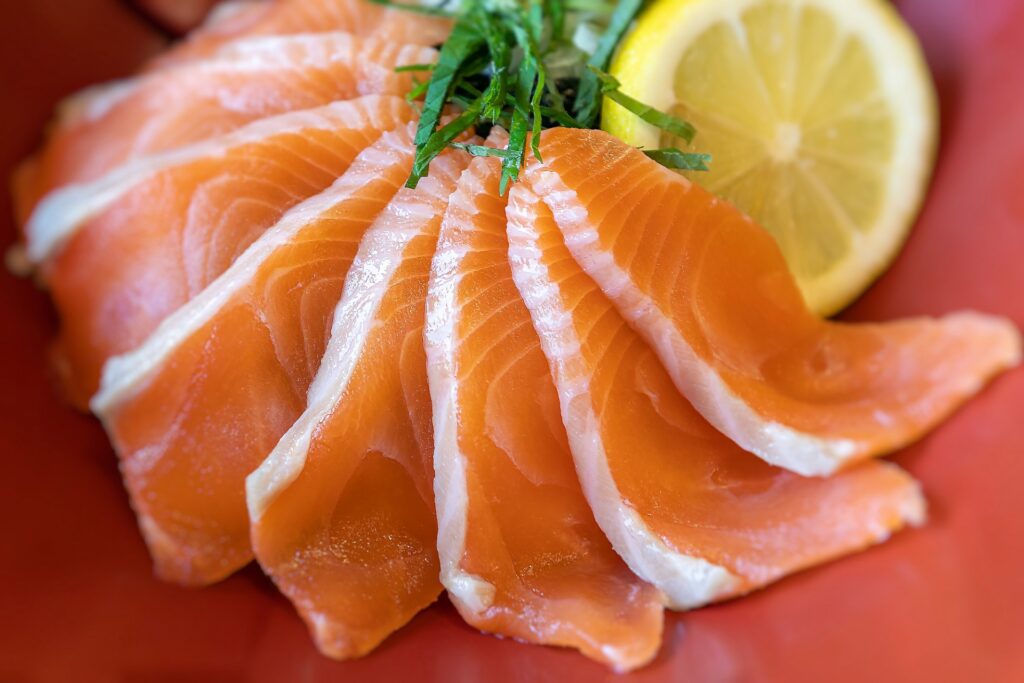
Salmon is sometimes called a superfood because of the various health and beauty benefits it is thought to have.
We have ranked the eight types of salmon sold in Japan in order of lowest calorie content and compared their nutritional content. Data are given for vitamins, essential minerals, DHA, EPA, and astaxanthin per 100g of edible portion. This data was taken from the Salmon Museum website and the Japanese Standard Tables of Food Composition. As it is not widely available in Japan, we could not find nutritional data for some natural Atlantic salmon.
In general, salmon is low in fat and calories compared to meat and is rich in n-3 fatty acids and astaxanthin, etc., so it is sometimes called a superfood because of the various health and beauty benefits it is thought to have.
Chum salmon (Dog salmon)
Chum salmon has the lowest fat content and the fewest calories. It has the highest levels of vitamin B2 and iron of the eight types of salmon and the lowest levels of fat, DHA, and vitamin A.
Vitamin B2 helps metabolize fats and maintains healthy skin and mucous membranes. Iron deficiency can cause symptoms such as headaches, dizziness, palpitations, shortness of breath, poor concentration, and loss of appetite. In addition, a decrease in myoglobin in the muscles can lead to a decrease in muscle strength and feelings of fatigue. The recommended amount of vitamin B2 for adults is 1.6mg for men aged 18-49, 1.5mg for men aged 50-74, and 1.3mg for men aged 75 and over. For women, the recommended amount is 1.2mg for women aged 18-74 and 1.0mg for women aged 75 and over.
This is the type of salmon that has been eaten in Japan for a long time and is the type of salmon that most people think of when they think of sake in Japan, but you rarely see it in conveyor belt sushi restaurants. It is 100% natural.
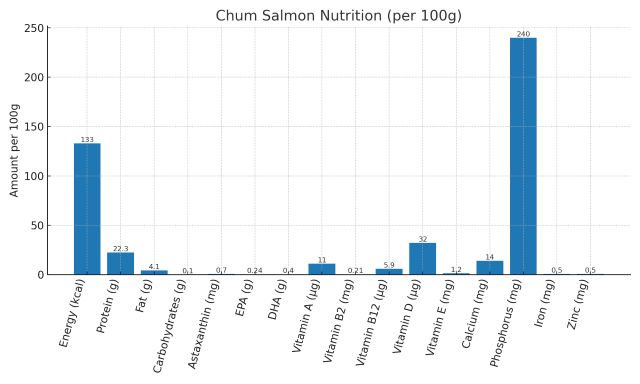
<Chum salmon Nutrition>
Energy per 100g: 133kcal
Protein: 22.3g
Fat: 4.1g
Carbohydrates: 0.1g
Astaxanthin: 0.7mg
EPA: 0.24g
DHA: 0.4g
Vitamin A: 11μg
Vitamin B2: 0.21mg
Vitamin B12: 5.9μg
Vitamin D: 32μg
Vitamin E: 1.2mg
Calcium: 14mg
Phosphorus: 240mg
Iron: 0.5mg
Zinc: 0.5mg.
Red salmon (Sockeye salmon)
As the name suggests, this type of salmon is characterized by its red flesh. It is one of the leanest types of salmon, with 4.5g of fat per 100g of protein, compared to 22.5g of protein. Of the eight types, it has the highest levels of astaxanthin, vitamin B12, and vitamin D.
Vitamin B12 is important in metabolizing carbohydrates, fats, and proteins and converting them into energy. Vitamin B12, along with folic acid, is a necessary component in the production of red blood cells. If you are deficient, you will have a reduced number of normal red blood cells and an increased risk of developing pernicious anemia, which is accompanied by dizziness and loss of appetite, as well as atherosclerosis. Eating about 50 grams of salmon provides the recommended daily amount of vitamin B12 for an adult.
Vitamin D is an essential nutrient that helps protect and control nerve cells in the brain. For this reason, it is thought that consuming high levels of vitamin D may help prevent Alzheimer’s disease and dementia. According to research published by the American Academy of Neurology in 2014, vitamin D deficiency was found to increase the risk of developing dementia by 53%.
Astaxanthin, a red natural pigment also known as “the carotenoid of the sea”, is a major pigment component of salmon and has powerful antioxidant properties. It is also found in red-colored shrimp, crabs, sea breams, etc. It is said that astaxanthin has 6,000 times the antioxidant power of vitamin C and 1,000 times that of vitamin E, and is effective in preventing aging and relieving fatigue. It is also said to prevent arteriosclerosis and burn fat efficiently during exercise. Astaxanthin is found in greater quantities in red salmon than in chum salmon. According to research results announced by Tsukuba University in 2019, astaxanthin has been reported to have the effect of activating the hippocampus and improving learning and memory ability.
On the other hand, EPA and DHA are less abundant than in the high-EPA/DHA group.
Like chum salmon, it cannot be farmed and is only available wild-caught. In Japan, it is often used in onigiri (rice balls) sold in convenience stores. It is often sold in the form of frozen salmon from Japan or Russia, so you will often see it in supermarkets. However, it is a bit expensive.
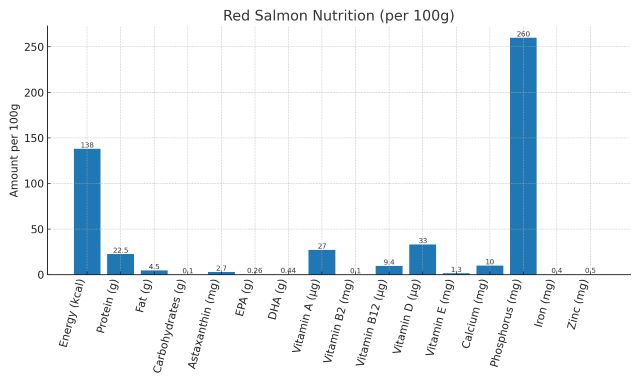
<Red salmon Nutrition>
Energy per 100g: 138 kcal
Protein: 22.5g
Fat: 4.5g
Carbohydrates: 0.1g
Astaxanthin: 2.7mg
EPA: 0.26g
DHA: 0.44g
Vitamin A: 27μg
Vitamin B2: 0.1mg
Vitamin B12: 9.4μg
Vitamin D: 33μg
Vitamin E: 1.3mg
Calcium: 10mg
Phosphorus: 260mg
Iron: 0.4mg
Zinc: 0.5mg.
Pink salmon (Humpback salmon)
You won’t often see it as a fillet in supermarkets, but it is sold as canned salmon. The less expensive ikura is also made from pink salmon. It is lower in calories and fat than mackerel. It has the highest zinc content of the eight types and the lowest levels of astaxanthin and vitamin E.
If you are deficient in zinc, you may experience symptoms such as impaired immune function and sensory nerves, dermatitis, chronic diarrhea, anemia, loss of appetite, impaired reproductive function, and hair loss. In addition, your sense of smell and hearing may also be impaired.
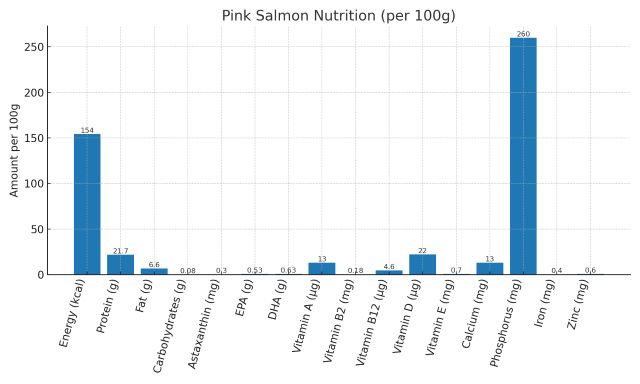
<Pink salmon Nutrition>
Energy per 100g: 154kcal
Protein: 21.7g
Fat: 6.6g
Carbohydrates: 0.08g
Astaxanthin: 0.3mg
EPA: 0.53g
DHA: 0.63g
Vitamin A: 13μg
Vitamin B2: 0.18mg
Vitamin B12: 4.6μg
Vitamin D: 22μg
Vitamin E: 0.7mg
Calcium: 13mg
Phosphorus: 260mg
Iron: 0.4mg
Zinc: 0.6mg.
Cherry salmon (Masu salmon)
Cherry salmon has recently become a “mythical high-end fish” because its numbers have drastically declined in recent years as a result of the development of dams and rivers that have damaged its natural environment.
Because aquaculture is still in its infancy, it is not yet commercially viable. The meat is rich in fat but light in flavor, making it a true delicacy. It is used as an ingredient in the famous Toyama specialty, Masuzushi.
Fish collagen is another nutrient that can be obtained from salmon. Fish collagen is characterized by the fact that it is more easily absorbed by the body than the collagen found in cows, pigs, etc. By consuming fish collagen, the moisture content of the skin is improved and it effectively keeps the skin hydrated and elastic.
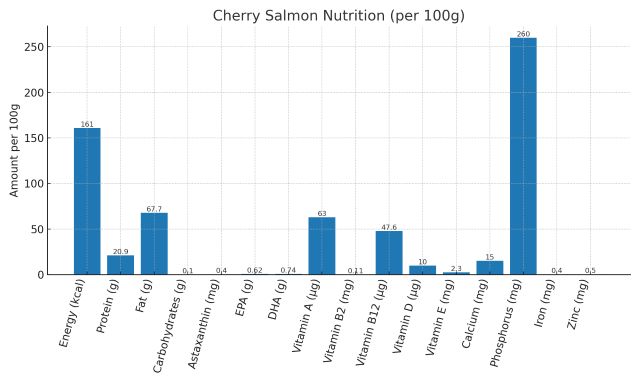
<Cherry salmon Nutrition>
Energy per 100g: 161kcal
Protein: 20.9g
Fat: 67.7g
Carbohydrates: 0.1g
Astaxanthin: 0.4mg
EPA: 0.62g
DHA: 0.74g
Vitamin A: 63μg
Vitamin B2: 0.11mg
Vitamin B12: 47.6μg
Vitamin D: 10μg
Vitamin E: 2.3mg
Calcium: 15mg
Phosphorus: 260mg
Iron: 0.4mg
Zinc: 0.5mg.
King salmon (Chinook salmon)
The meat is orange in color and is characterized by its rich flavor and high fat content. Most of the king salmon consumed in Japan is imported from Alaska, Canada, Chile and New Zealand. In recent years, it has become possible to farm king salmon in countries such as New Zealand, which was previously thought to be difficult. Of the eight types of salmon, king salmon has the highest vitamin A content and the lowest vitamin B12 and zinc content.
Vitamin A is an essential vitamin for maintaining healthy skin, mucous membranes, and eyes. It is also known to have antioxidant properties and is a nutrient that can be expected to have effects not only on maintaining and improving health but also on beauty and anti-aging.
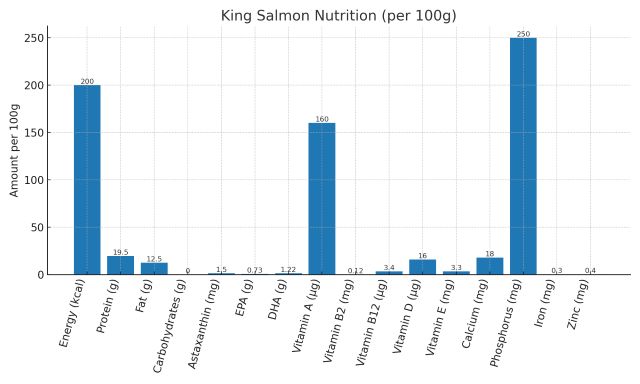
<King salmon Nutrition>
Energy per 100g: 200 kcal
Protein: 19.5g
Fat: 12.5g
Carbohydrates: 0g
Astaxanthin: 1.5mg
EPA: 0.73g
DHA: 1.22g
Vitamin A: 160μg
Vitamin B2: 0.12mg
Vitamin B12: 3.4μg
Vitamin D: 16μg
Vitamin E: 3.3mg
Calcium: 18mg
Phosphorus: 250mg
Iron: 0.3mg
Zinc: 0.4mg.
Silver salmon (Coho salmon)
It has a silvery skin and pink flesh that is paler than red salmon. It is mainly farmed and inexpensive, so when people think of “sake” in Japan, this is usually what they mean. Japan has a long history of working with Chile to develop silver salmon farming. In Japan, it is also called chirigin (chiri means Chile and gin means silver). Compared to red salmon, it has more than twice the amount of fat and therefore a higher caloric content. However, it’s only half as much as pork belly, so we don’t think you need to worry about it any more than you have to. The wild fish, mainly imported from Alaska, have a color between chum and sockeye salmon and are delicious with a moderate amount of fat. They are used for salt-grilled, meuniere, and fried dishes. Those farmed in Japan are also used for sashimi. It has the highest zinc and phosphorus content of the eight types.
Phosphorus is a major component of bones and teeth in the form of calcium phosphate and magnesium phosphate in the body, and in the bloodstream, it works to neutralize acids and alkalis in the blood as phosphates.
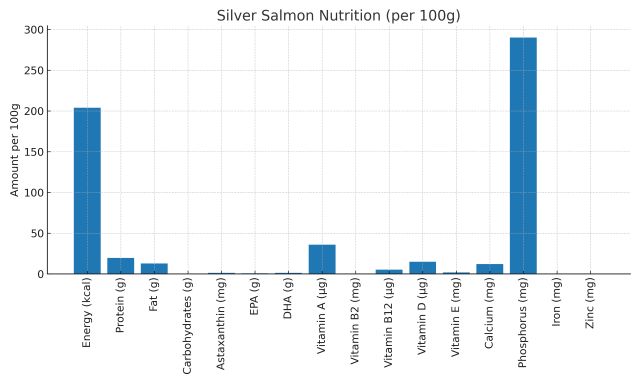
<Silver salmon Nutrition>
Energy per 100g: 204kcal
Protein: 19.6g
Fat: 12.8g
Carbohydrates: 0.3g
Astaxanthin: 1.4mg
EPA: 0.75g
DHA: 1.25g
Vitamin A: 36μg
Vitamin B2: 0.15mg
Vitamin B12: 5.2μg
Vitamin D: 15μg
Vitamin E: 1.8mg
Calcium: 12mg
Phosphorus: 290mg
Iron: 0.3mg
Zinc: 0.6mg
Trout salmon (Salmon trout)
This is a type of rainbow trout that is farmed in the sea. The flesh is a beautiful red color, and it is soft and has no fishy odor, so it is used for sashimi, sushi toppings, grilled with salt, fried, smoked, canned, etc. It is a standard topping in conveyor belt sushi restaurants. It has more fat and calories than silver salmon, although the difference is not significant. It has the highest levels of DHA and vitamin E of the eight types and the lowest levels of iron.
DHA and EPA are two types of essential fatty acids. Fatty acids can be broadly divided into two categories: non-essential fatty acids and essential fatty acids. The body can synthesize non-essential fatty acids, but essential fatty acids must be obtained from food. They are found in the fat of fish, and salmon is rich in them. DHA and EPA are thought to help prevent blood clots, reduce bad cholesterol and neutral fat in the blood, improve brain and nerve tissue function, and have a relaxing effect.
Vitamin E prevents the oxidation of lipids contained in cells and blood. The recommended amount of vitamin E for adults is 6.0mg for men aged 18-49, 7.0mg for men aged 50-74, and 6.5mg for men aged 75 and over. For women, the recommended amount is 5.0mg for those aged 18-29, 5.5mg for those aged 30-49, 6.0mg for those aged 50-64, and 6.5mg for those aged 65 and over.
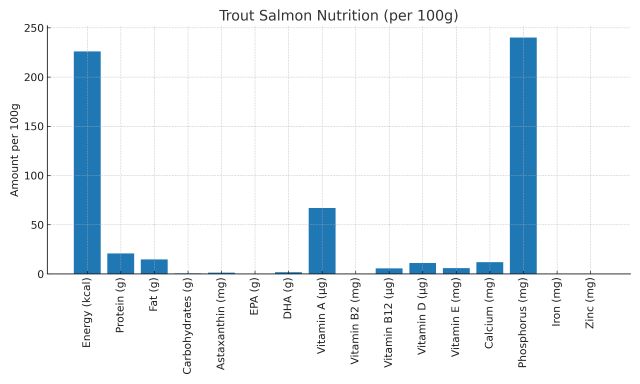
<Trout salmon Nutrition>
Energy per 100g: 226kcal
Protein: 20.8g
Fat: 14.7g
Carbohydrates: 0.6g
Astaxanthin: 1.4mg
EPA: 0.44g
DHA: 1.76g
Vitamin A: 67μg
Vitamin B2: 0.09mg
Vitamin B12: 5.7μg
Vitamin D: 11μg
Vitamin E: 5.8mg
Calcium: 12mg
Phosphorus: 240mg
Iron: 0.2mg
Zinc: 0.4mg
On the other hand, freshwater rainbow trout is low in calories but high in protein, vitamins, minerals and unsaturated fatty acids. Vitamin B12 is found only in animal foods such as fermented soybeans. The Ministry of Health, Labor and Welfare has set the recommended daily intake of vitamin B12 at 2.4µg or more, so rainbow trout contains about 2.5 times that amount (6µg). DHA, which is found in large quantities in fish oil, is said to be most abundant in Blue-backed fish. It is not widely known that rainbow trout contains about 552 mg of DHA, which is 1.5 times more than the amount found in the Blue-backed horse mackerel. It also has a good balance of calcium, phosphorus, and zinc. It contains the most calcium of the eight species.
If you are deficient in calcium, you may experience symptoms such as brittle bones and teeth, high blood pressure, hardened and brittle blood vessels, abnormal immune function, and deformed cartilage. In addition, if you are extremely low in calcium, you may experience increased nervousness and muscle excitability and you may be more likely to experience muscle and body cramps.
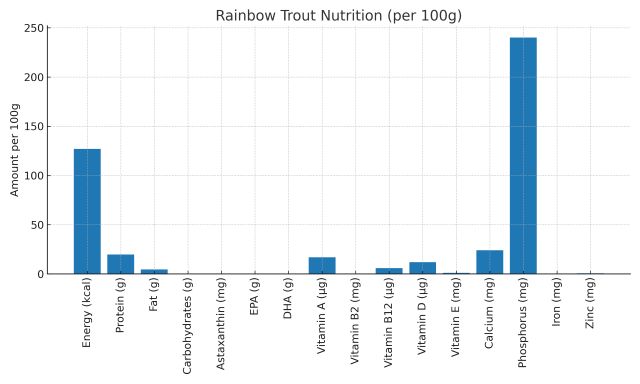
<Rainbow trout Nutrition>
Energy per 100g: 127kcal
Protein: 19.7g
Fat: 4.6g
Carbohydrates: 0g
Astaxanthin: 0.4mg
EPA: 0.14g
DHA: 0.55g
Vitamin A: 17μg
Vitamin B2: 0.1mg
Vitamin B12: 6.0μg
Vitamin D: 12μg
Vitamin E: 1.2mg
Calcium: 24mg
Phosphorus: 240mg
Iron: 0.2mg
Zinc: 0.6mg
Atlantic salmon
Atlantic salmon, like trout salmon, is often seen in the form of sashimi or sushi in supermarkets and conveyor belt sushi restaurants. It has the highest fat content of the eight types and is high in calories. Although the high-fat content may give a negative impression, salmon fat is rich in n-3 fatty acids, which are essential fatty acids (EPA is the highest of the 8 types, and DHA is the second highest). These are vulnerable to heat, so we recommend eating them raw, such as in sashimi. And it has the lowest levels of vitamin B2, vitamin D, and zinc.
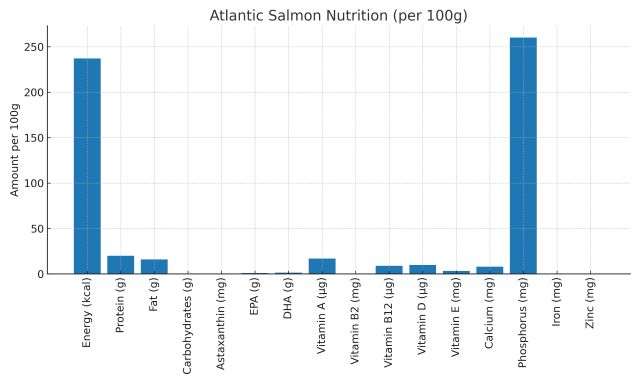
<Atlantic salmon Nutrition>
Energy per 100g: 237kcal
Protein: 20.1g
Fat: 16.1g
Carbohydrates: 0.1g
Astaxanthin: 0.5mg
EPA: 0.94g
DHA: 1.57g
Vitamin A: 17μg
Vitamin B2: 0.09mg
Vitamin B12: 8.9μg
Vitamin D: 10μg
Vitamin E: 3.4mg
Calcium: 8mg
Phosphorus: 260mg
Iron: 0.3mg
Zinc: 0.4mg
On the other hand, the wild Atlantic salmon population is decreasing due to the deterioration of the environment in the rivers where they spawn. It can be said that wild Atlantic salmon do not have as much fat and are not as high in calories as farmed Atlantic salmon. Overall, the nutritional data is similar to that of other wild salmon. The data also shows that farmed fish take in EPA and DHA by mixing them into their feed.
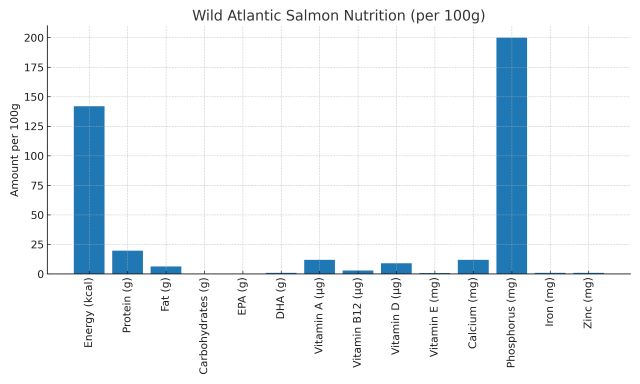
<Wild Atlantic salmon Nutrition>
Energy per 100g: 142kcal
Protein: 19.8g
Fat: 6.3g
Carbohydrates: 0g
Astaxanthin: -
EPA: 0.3g
DHA: 1.0g
Vitamin A: 12μg
Vitamin B2: -
Vitamin B12: 3.0μg
Vitamin D: 9μg
Vitamin E: 0.7mg
Calcium: 12mg
Phosphorus: 200mg
Iron: 1.0mg
Zinc: 1.0mg
Salmon also contains moderate amounts of other vitamins, such as vitamin B6 and niacin.
Vitamin B6 is a component that is used in the body when synthesizing amino acids. It is essential for promoting the growth of skin and hair, and for maintaining normal immune function. The recommended amount of vitamin B6 for adults is 1.4mg for men and 1.1mg for women.
Niacin is involved in the production of energy and the synthesis of fatty acids, which are a component of lipids. A niacin deficiency can cause pellagra, a disease that manifests as symptoms such as dermatitis and diarrhea.
Summary
So what did you think? To put it simply, these are the only types of salmon used for sushi. Salmon trout and Atlantic salmon are used in things like California rolls, so you have probably eaten them before. But if you see a rare topping such as Masunosuke, Tokishirazu, Keiji, or Sakuramasu in the topping case, don’t hesitate to order. I’m sure you will be moved by the way the Edo-style sushi brings out the maximum umami of the fat, without killing the flavor of the wild salmon. Just for your reference.
Related Contents
Salmon is not used as a topping in Edo-style sushi!
Reevaluating the serious risk to health posed by farmed salmon!
What is Yellow caviar in Japan?
What is the trick to super cheap Ikura at conveyor belt sushi restaurants?
What is Blue rainbow trout (Cobalt masu)?
The ‘wild’ salmon on your menu might not be wild
Share this article